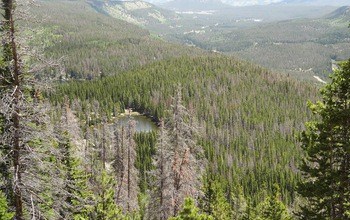On Earth Week–and in fact, every week now–trees in mountains across the western United States are dying, thanks to an infestation of bark beetles that reproduce in the trees’ inner bark.
Some species of the beetles, such as the mountain pine beetle, attack and kill live trees. Others live in dead, weakened or dying hosts.
In Colorado alone, the mountain pine beetle has caused the deaths of more than 3.4 million acres of pine trees.
What effect do all these dead trees have on stream flow and water quality? Plenty, according to new research findings reported this week.
Dead trees don’t drink water
“The unprecedented tree deaths caused by these beetles provided a new approach to estimating the interaction of trees with the water cycle in mountain headwaters like those of the Colorado and Platte Rivers,” says hydrologist Reed Maxwell of the Colorado School of Mines.
Maxwell and colleagues have published results of their study of beetle effects on stream flows in this week’s issue of the journal Nature Climate Change.
As the trees die, they stop taking up water from the soil, known as transpiration. Transpiration is the process of water movement through a plant and its evaporation from leaves, stems and flowers.
The “unused” water then becomes part of the local groundwater and leads to increased water flows in nearby streams.
The research is funded by the National Science Foundation’s (NSF) Water, Sustainability and Climate (WSC) Program. WSC is part of NSF’s Science, Engineering and Education for Sustainability initiative.
“Large-scale tree death due to pine beetles has many negative effects,” says Tom Torgersen of NSF’s Directorate for Geosciences and lead WSC program director.
“This loss of trees increases groundwater flow and water availability, seemingly a positive,” Torgersen says.
“The total effect, however, of the extensive tree death and increased water flow has to be evaluated for how much of an increase, when does such an increase occur, and what’s the water quality of the resulting flow?”
The answers aren’t always good ones.
Green means go, red means stop, even for trees
Under normal circumstances, green trees use shallow groundwater in late summer for transpiration.
Red- and gray-phase trees–those affected by beetle infestations–stop transpiring, leading to higher water tables and greater water availability for groundwater flow to streams.
The new results show that the fraction of late-summer groundwater flows from affected watersheds is about 30 percent higher after beetles have infested an area, compared with watersheds with less severe beetle attacks.
“Water budget analysis confirms that transpiration loss resulting from beetle kill can account for the increase in groundwater contributions to streams,” write Maxwell and scientists Lindsay Bearup and John McCray of the Colorado School of Mines, and David Clow of the U.S. Geological Survey, in their paper.
Dead trees create changes in water quality
“Using ‘fingerprints’ of different water sources, defined by the sources’ water chemistry, we found that a higher fraction of late-summer streamflow in affected watersheds comes from groundwater rather than surface flows,” says Bearup.
“Increases in stream flow and groundwater levels are very hard to detect because of fluctuations from changes in climate and in topography. Our approach using water chemistry allows us to ‘dissect’ the water in streams and better understand its source.”
With millions of dead trees, adds Maxwell, “we asked: What’s the potential effect if the trees stop using water? Our findings not only identify this change, but quantify how much water trees use.”
An important implication of the research, Bearup says, is that the change can alter water quality.
The new results, she says, help explain earlier work by Colorado School of Mines scientists. “That research found an unexpected spike in carcinogenic disinfection by-products in late summer in water treatment plants.”
Where were those water treatment plants located? In bark beetle-infested watersheds.



Bark beetles are common pests which belong to the family Curculionidae. They are commonly known to come from the family Scolytidae. This article is so interesting because it shows us how mysterious can be. How can something so small destroy something so big? This is where science comes in. Bark beetles kill living trees by reproducing in the bark (living and dead phloem tissues) of trees.
Although bark beetles destroy trees, they are, at some point, ecologically important. Why? This is because bark beetles help renew the forests by killing trees which are old and by bashing disease stricken trees. By doing this I think bark beetles are somehow reducing water contamination.
Bark beetles are common pests which belong to the family Curculionidae. They are commonly known to come from the family Scolytidae. This article is so interesting because it shows us how mysterious can be. How can something so small destroy something so big? This is where science comes in. Bark beetles kill living trees by reproducing in the bark (living and dead phloem tissues) of trees.
Although bark beetles destroy trees, they are, at some point, ecologically important. Why? This is because bark beetles help renew the forests by killing trees which are old and by bashing disease stricken trees. By doing this I think bark beetles are somehow reducing water contamination.
I really enjoyed reading this, I only wish more detail was included about the mountain pine beetle themselves and other similar species for example more detail on how they destroy these trees as this is a very big problem, yet very interesting. I also would have liked to possibly see some solutions added to this article on how to remedy the problems caused by these beetles.